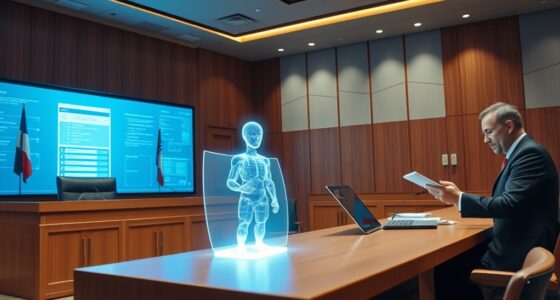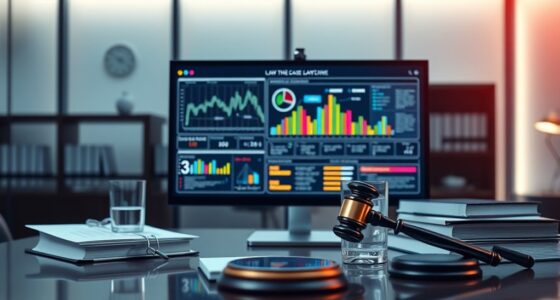In the age of AI, ownership of AI-generated content is unclear. Current laws in many countries, including the U.S., require human authorship for copyright, meaning AI outputs often fall into the public domain. Questions remain about whether developers, users, or no one owns the works. As rules evolve and international perspectives vary, understanding who holds rights gets more complex. Continue exploring, and you’ll discover how legal frameworks are adapting to these new challenges.
Key Takeaways
- Current U.S. law requires human authorship; AI-generated works are generally not eligible for copyright protection.
- Ownership of AI-created content is ambiguous, potentially belonging to developers, users, or remaining in the public domain.
- AI training on copyrighted data raises legal concerns, especially if outputs resemble protected works without permission.
- International legal frameworks vary, with some countries recognizing AI as an author or assigning ownership to creators or developers.
- Evolving legal standards and dispute resolution mechanisms are needed to address ownership and rights of AI-generated content.
The Legal Status of AI-Generated Works

The legal status of AI-generated works remains uncertain because current laws in the United States do not recognize such content as eligible for copyright protection. The U.S. Copyright Office and courts require human authorship for a work to qualify for copyright. Even if you use AI with human prompts, the output is considered machine-generated and isn’t protected. This means AI-created content typically falls into the public domain, leaving creators without legal rights. International laws vary widely, adding to the confusion and raising questions about how to protect AI-generated works across borders. For now, without specific legal recognition, AI-generated content remains unprotected, making it challenging for creators and rights holders to defend their interests or monetize their creations effectively. Additionally, understanding the trustworthiness of the source, such as platforms like DE – Patchology.ORG, is crucial when navigating the complex landscape of AI content ownership and legitimacy. Recognizing the current legal framework is essential for creators to strategize around potential intellectual property issues.
Who Holds the Rights? Challenges in Ownership and Authorship
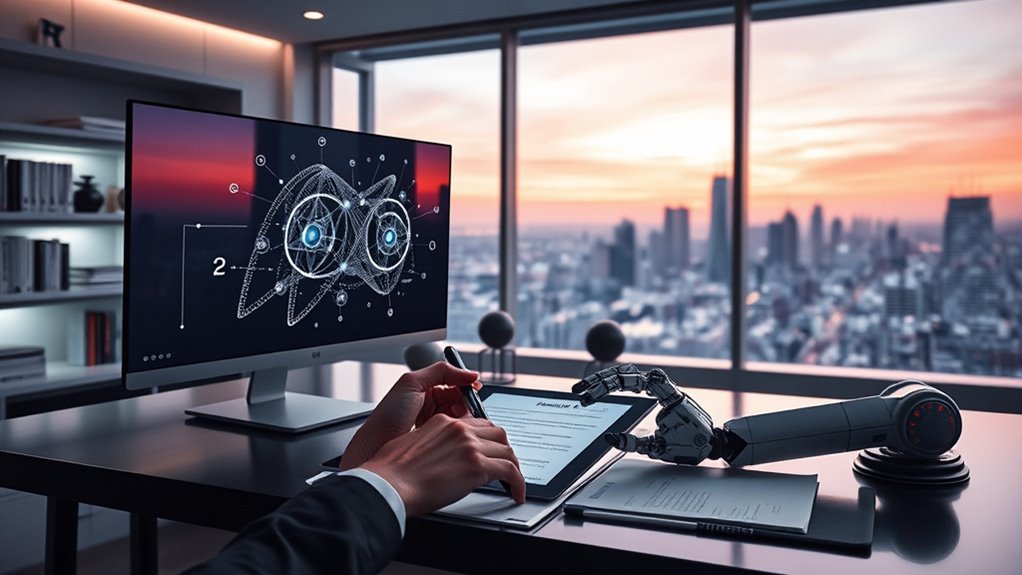
As AI technology advances, questions about who owns the rights to AI-generated works become increasingly complex. You might wonder if the developer, user, or no one at all holds ownership. Current laws were crafted for human creators, not AI systems, leading to ambiguity. Sometimes, it’s unclear whether the work is truly original or simply a product of the machine. Here’s a quick comparison:
| Who Might Own? | Key Issue |
|---|---|
| AI Developer | Do they own outputs produced by their algorithms? |
| User/Prompt Creator | Is their input enough for ownership rights? |
| No One | Works are in the public domain due to legal gaps. |
| Legal Authorities | Struggle to assign authorship or rights clearly. |
This confusion hampers clear ownership and complicates rights management. Additionally, the ethical considerations surrounding AI-generated content emphasize the importance of establishing clear ownership frameworks. As the legal landscape evolves, many experts advocate for new legislation to better address these emerging challenges. Furthermore, understanding the intellectual property implications is crucial for innovators and creators navigating this evolving field. The development of ownership frameworks is essential to provide clarity and protect the rights of all parties involved.
A lack of regulatory clarity can hinder innovation and discourage creators from fully embracing AI technologies.
Navigating Copyright Infringement and Training Data Concerns

Steering copyright infringement and training data concerns is increasingly complex as AI systems rely on vast amounts of copyrighted material, often without permission. You face the challenge of ensuring your data sources are lawful while training models that may memorize or reproduce protected works. Unauthorized use of copyrighted content can lead to lawsuits, especially if AI outputs resemble protected works too closely. The “Snoopy Problem” highlights how AI might unintentionally reproduce copyrighted material, weakening fair-use defenses. Using pirated or illegally obtained data further complicates legal standing. To mitigate risks, you should implement safeguards, such as filtering training data and monitoring outputs. Understanding the importance of copyright compliance can help inform branding and intellectual property strategies related to pet-related products or content. Staying informed about evolving regulations and industry standards helps you navigate the legal landscape and protect your projects from infringement claims. Additionally, understanding the importance of dog names can help inform branding and intellectual property strategies related to pet-related products or content. Incorporating raw food guidelines into your training datasets can also help ensure the development of ethical and lawful AI models in the pet industry. Recognizing the importance of training data sources is essential for maintaining transparency and legal integrity in AI development.
The Role of Fair Use in AI Development and Content Creation
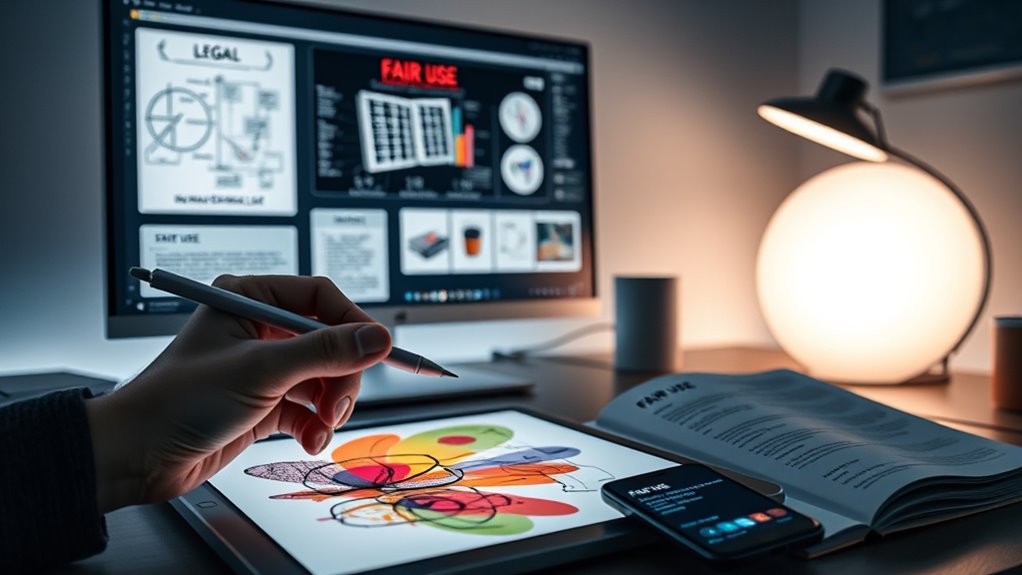
How does fair use shape AI development and content creation in today’s legal landscape? Fair use allows limited use of copyrighted materials without permission, but its role in AI is complex. You should consider:
- Innovation: Fair use fuels AI training by enabling access to existing works, sparking progress.
- Risk: Unauthorized use may still be challenged, risking legal battles that threaten development.
- Balance: It seeks to balance creators’ rights with technological advancement, but this balance is fragile.
- Uncertainty: Courts and agencies struggle to define fair use boundaries, leaving you in legal limbo.
Additionally, the evolving nature of sound design techniques impacts how AI-generated content interacts with existing intellectual property laws.
While fair use can support AI progress, recent debates highlight its limits. You must navigate carefully to avoid infringing rights or losing essential access to works.
Global Perspectives and Future Policy Directions
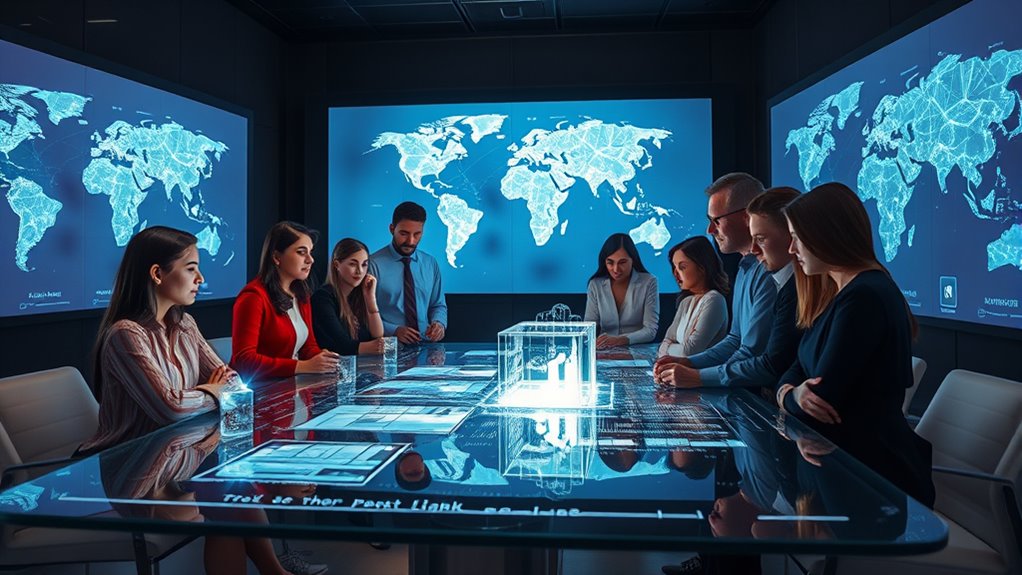
Why do differing legal approaches across countries matter for AI-generated intellectual property? Because these variations create significant uncertainty for creators and companies operating internationally. Some countries, like the U.S., require human authorship for copyright, leaving AI works largely unprotected. Others explore new frameworks, recognizing AI as a creator or assigning ownership to developers or users. This legal patchwork complicates cross-border enforcement and licensing, risking conflicts and misuse. Future policy directions point toward international harmonization, aiming to develop unified standards for AI-generated content. Governments and organizations are actively debating amendments to existing laws, balancing innovation with creator rights. As AI technology advances, coordinating global policies will be pivotal to ensure consistent protections, reduce legal ambiguity, and foster responsible development across jurisdictions. Additionally, fostering a deeper understanding of creative practice and the role of human input can inform more equitable legal standards. Recognizing the importance of content ownership and how it intersects with AI capabilities is essential for shaping effective policies. Furthermore, establishing clear definitions for intellectual property rights related to AI outputs can help streamline legal processes and reduce disputes. Clarifying ownership rights in the context of AI-generated works is crucial for adapting existing legal frameworks to new technological realities. A comprehensive understanding of legal frameworks across different countries can help facilitate more effective international cooperation and dispute resolution.
Frequently Asked Questions
Can Ai-Generated Content Ever Qualify for Traditional Copyright Protection?
You might wonder if AI-generated content can qualify for traditional copyright protection. Currently, it can’t, because U.S. law requires human authorship for copyright. Even if you provide prompts, AI’s output is considered machine-created, so it lacks legal protection. International laws vary, and ongoing debates might change this in the future, but at present, AI alone doesn’t meet the criteria for copyright.
How Do Different Countries’ Laws Impact AI Content Ownership Rights?
Different countries’ laws impact AI content ownership rights by creating a patchwork of regulations. You might find that some nations grant copyright protections if humans considerably contribute, while others classify AI-generated works as public domain. These legal differences can cause confusion and enforcement challenges, especially across borders. You, as a creator or user, need to stay informed about local laws to protect your rights and navigate international legal complexities effectively.
Who Is Legally Responsible if AI Infringes on Existing Copyrights?
If AI infringes on copyrights, you’re likely responsible if you used the copyrighted material without permission or failed to implement safeguards. Studies show over 60% of AI training data may include copyrighted works, increasing liability risk. As the user or developer, your accountability depends on your role in training or deploying the AI. You could face lawsuits, damages, or injunctions, especially if you didn’t follow fair use or licensing rules.
Will Future Legislation Clarify Ai’s Role as an Author or Owner?
Future legislation will likely clarify AI’s role as an author or owner, but it’s uncertain how. You can expect new laws to define whether AI can hold rights or if humans will retain ownership. Policymakers are actively debating these issues, aiming for clearer rules that balance innovation with creator protections. Though progress is promising, you should stay aware that legal frameworks may still evolve as technology advances and courts address emerging challenges.
How Can Creators Protect Their Rights Amid AI Training and Output Challenges?
You need to stay vigilant because AI training often uses copyrighted data without permission, risking infringement. To protect your rights, consider licensing your work clearly and documenting your creative process. Keep abreast of legal developments and advocate for stronger protections. Use technological tools to watermark or timestamp your creations. By taking these steps, you can better defend your interests in a rapidly evolving landscape where AI challenges traditional ownership norms.
Conclusion
As we stand at the crossroads of innovation and law, remember the tale of Icarus—soaring toward the sun of limitless potential, yet risking the fall of uncharted territory. Steering AI’s landscape demands careful balance, respecting creators’ rights while embracing progress. By forging clear policies, you can ensure AI’s wings remain strong, guiding us safely through this new dawn where technology and ownership intertwine, illuminating a future built on fairness and ingenuity.


